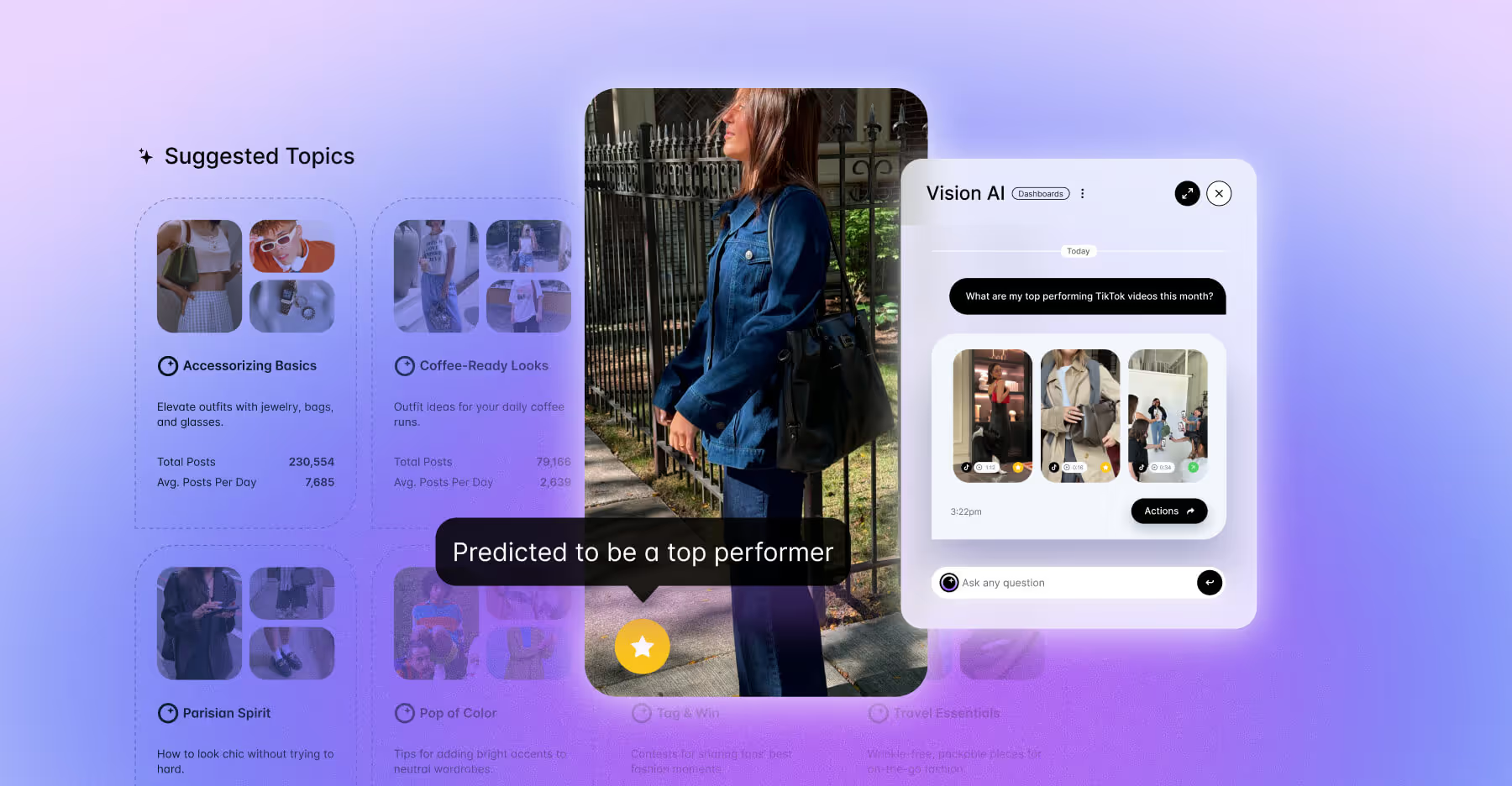28 AI Marketing Tools To Keep You One Step Ahead in 2026
Dive into the AI tools transforming modern marketing.

Artificial intelligence (AI) is changing how businesses and marketers create, manage, and optimize their marketing strategies and campaigns. From predicting social media trends and automating marketing emails to crafting engaging social content and uncovering consumer insights, AI tools are now essential in every marketer’s toolkit.
When it comes to achieving marketing success, balancing efficiency and personalization is key, and AI marketing tools help achieve both. Below, you’ll find a roundup of 28 of the best AI marketing tools across social media, content creation, customer insights, email-related, sales and operations, and data analysis, each designed to help marketers work smarter, not harder.
Quick AI Marking Tools Comparison Chart
What Are AI Marketing Tools?
AI marketing tools are software and platforms that use machine learning, natural language processing (NLP), predictive analytics, and automations to help marketers plan, execute, and measure their marketing efforts more effectively.
Both solo marketers and enterprise teams can leverage AI tools to amplify their creativity and efficiency, allowing them to focus more on strategizing and less on tasks that can be easily automated and don’t necessarily need that human touch.
There are various AI marketing tools in the market that can help you create content, manage workflows, and automate repetitive tasks, including scheduling and reporting, personalizing content, predicting campaign performance, and optimizing content.
Top 28 AI Marketing Tools
Social media is one of the most challenging spaces in marketing, and AI is helping marketers stay ahead of shifting trends and audience behavior. With AI-powered platforms that can aid at every stage of your workflow, we’ve compiled 28 of the most popular tools for data analysis, reporting, optimizing content, and more.
AI Tools For Social Media
AI is reshaping how brands connect with audiences on social media. These tools help marketers create smarter content, automate posting, and uncover performance insights faster than ever. Whether you’re focused on building engagement or tracking analytics, the right AI solution can make your social workflow more efficient and effective.
1. Dash Social
Dash Social provides content analysis AI and advanced automation solutions. With its proprietary Vision AI technology, marketers can quickly uncover which types of visuals resonate with their own audience and their competitors’ audiences, spot emerging industry trends, and use these insights to optimize future content. At the same time, Dash Social’s Scheduler leverages past performance data to auto-recommend the best posting times for each brand, helping ensure every post reaches its maximum potential. It’s used by teams at Unilever, Apple, and L'Oreal.
Pros:
- Very user-friendly, appreciated for straightforward navigation and campaign insights.
- Strong analytics and reporting capabilities, making tracking and decision-making easier.
- Responsive and helpful customer support, consistently mentioned in reviews.
Cons:
- Some users report limitations with integrations across multiple brands, sometimes requiring third-party tools.
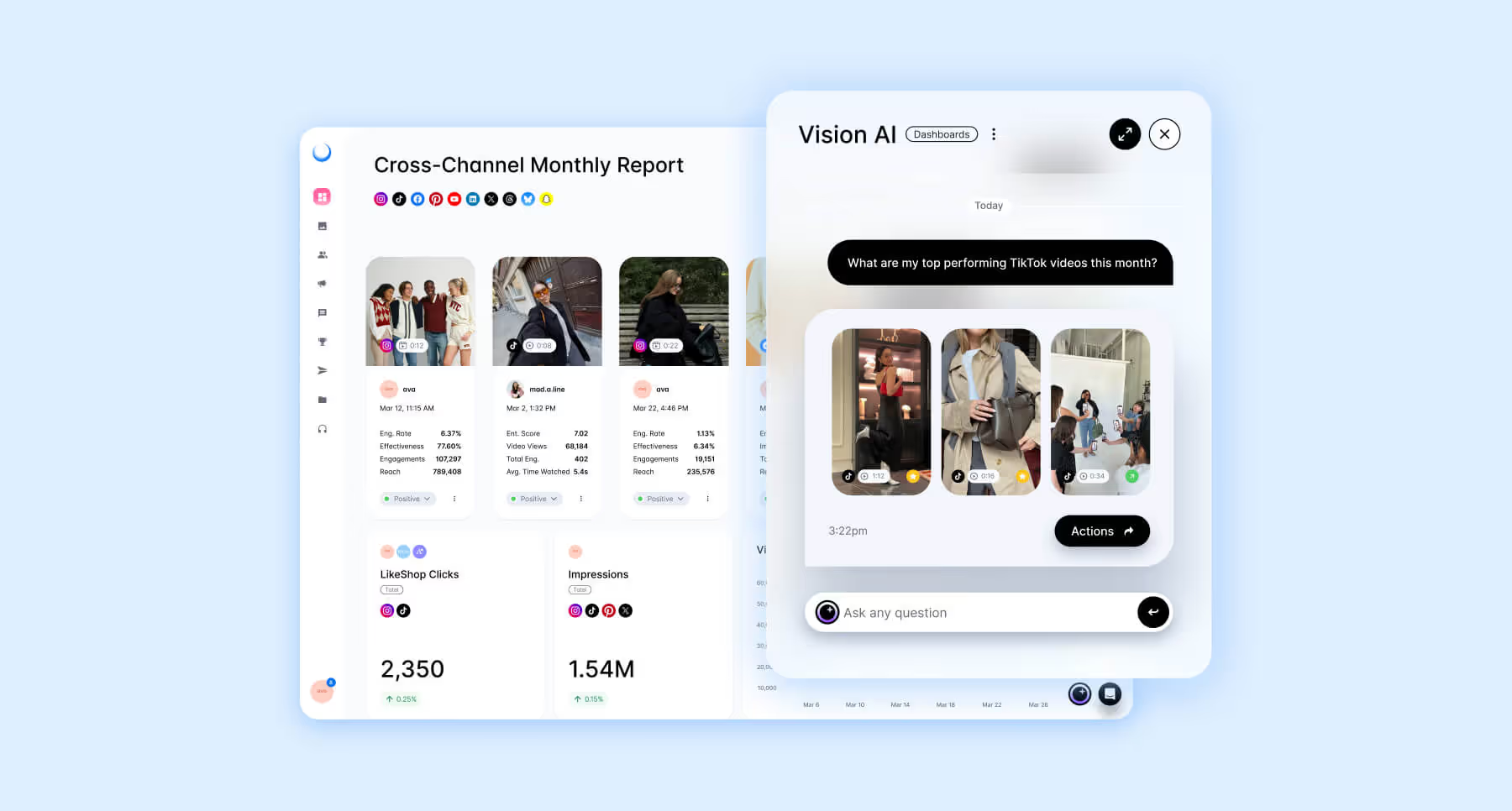
2. Adzooma
Adzooma’s AI helps manage and optimize PPC campaigns across Google, Microsoft, and Facebook Ads. Its AI engine analyzes multiple data points in real time and recommends actions to improve ROI, from adjusting bids to pausing underperforming keywords. It is especially valuable for marketers managing multiple ad accounts or operating with limited budgets.
Pros:
- Users report that it streamlines multi-channel ad management, which saves time and simplifies workflows.
- Effective at real-time optimization recommendations, which boost campaign efficiency.
Cons:
- Functionality may be less deep for highly advanced enterprise-level needs; some feedback notes limitations.
- Some users feel support or documentation could be improved for more complex use cases.
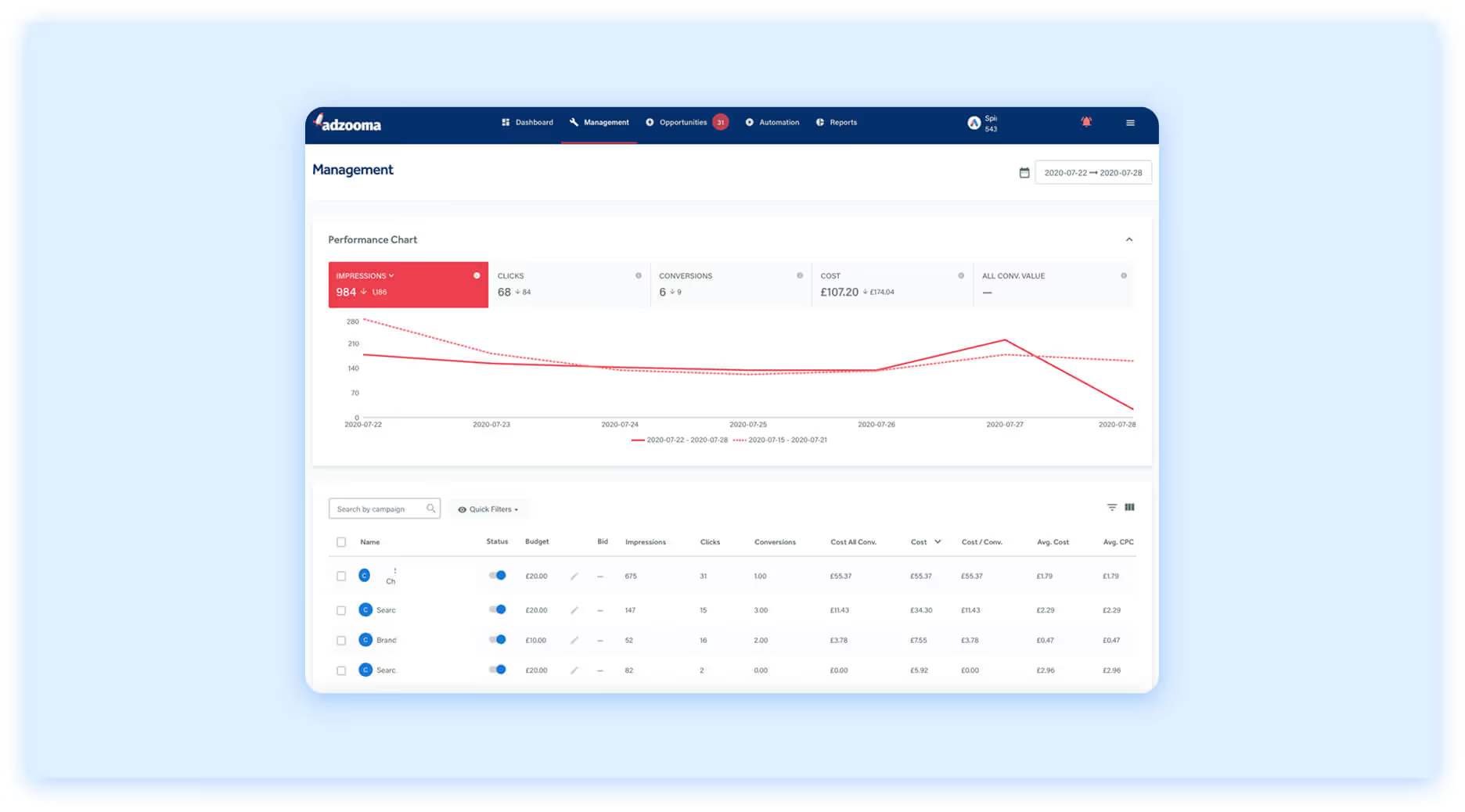
3. Runway
Runway is a cutting-edge AI platform for creating and editing audiovisual content with ease. Its powerful video toolset lets users remove or recreate elements, generate visuals from text prompts, animate static frames, and apply advanced special effects in just a few clicks. It’s an ideal solution for social media teams looking to produce professional-quality video content quickly.
Pros:
- Good user sentiment around collaboration features and the ability to save time in video creation workflows.
- Easy and user-friendly to generate and edit content with advanced AI.
Cons:
- Pricing for full feature sets may be too high for smaller teams or casual users.
- Some users report a learning curve and complexity on the platform.

4. Microsoft Copilot
There are two versions of Copilot: a general version that can answer questions and generate text, and a Microsoft 365-integrated version that leverages large language models to help marketers craft emails, summarize data, and brainstorm creative ideas directly within Microsoft apps like Word, Excel, and PowerPoint. It transforms natural language commands into actionable marketing materials and insights, making it an essential tool for teams of all kinds.
Pros:
- Enhances collaboration and productivity by integrating AI directly into Microsoft 365 workflows.
Cons:
- The cost and licensing may be steeper than smaller, standalone tools.
- Being part of a broader Microsoft ecosystem may limit flexibility if users prefer non-Microsoft workflows.

5. Smartly.AI
Smartly.AI is a conversational AI platform designed to enhance customer service through intelligent automation in over 70 languages. By leveraging advanced technologies such as Retrieval-Augmented Generation (RAG) and large language models, Smartly.AI powers AI chat and voicebots across multiple channels, including websites, mobile apps, WhatsApp, Messenger, phone calls, and more. This allows businesses to deploy AI agents that understand and respond to customer inquiries with high accuracy and contextual relevance, improving user satisfaction while reducing support costs.
Pros:
- Strong user feedback around its conversational AI and no-code creation of bots across channels.
- Able to deploy bots in multiple channels (web, mobile app, WhatsApp, and Messenger, for example) with advanced capabilities like voice-to-text.
Cons:
- While powerful, setting up advanced use cases may require technical resources or training.
- Depending on existing systems, integration into legacy stacks might take effort.
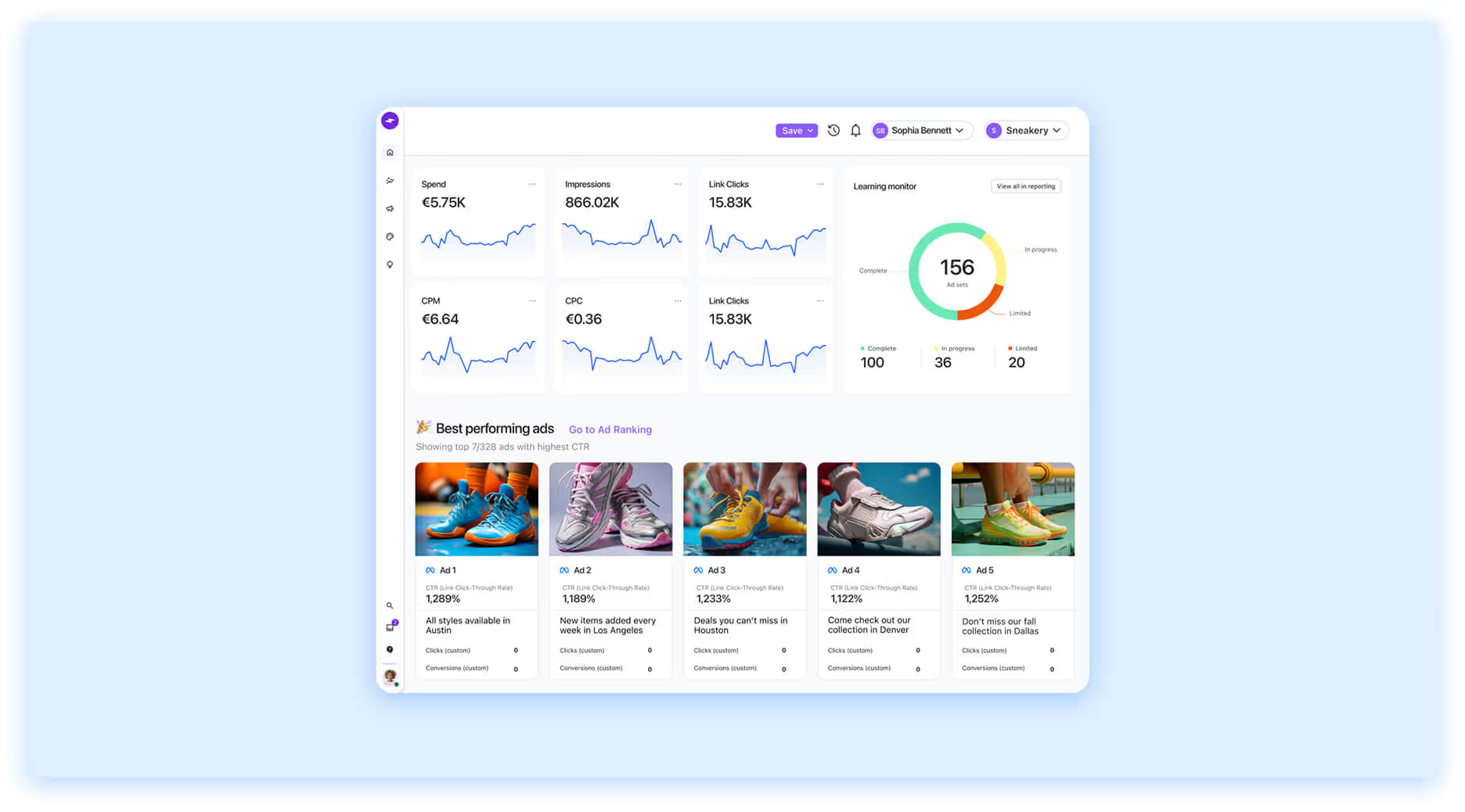
AI Tools For Content Creation and Optimization
AI content tools are redefining how marketers brainstorm, write, and produce creative assets. From copywriting and image generation to video production and presentation design, these tools help teams deliver content faster, and often, better.
6. ChatGPT
ChatGPT is a conversational AI by OpenAI that can help marketers brainstorm ideas, draft blogs, write captions, and even basic code automations by providing ChatGPT prompts. Its ability to generate high-quality, context-aware text makes it one of the most versatile AI writing assistants available.
Pros:
- Extremely versatile for marketers when it comes to brainstorming, drafting, automating tasks, and coding simple automations.
- Rapid iteration, easy to use for non-technical users.
Cons:
- Output may lack brand-specific nuance unless trained or refined carefully.
- Free or lower cost tiers may have usage or access limits.
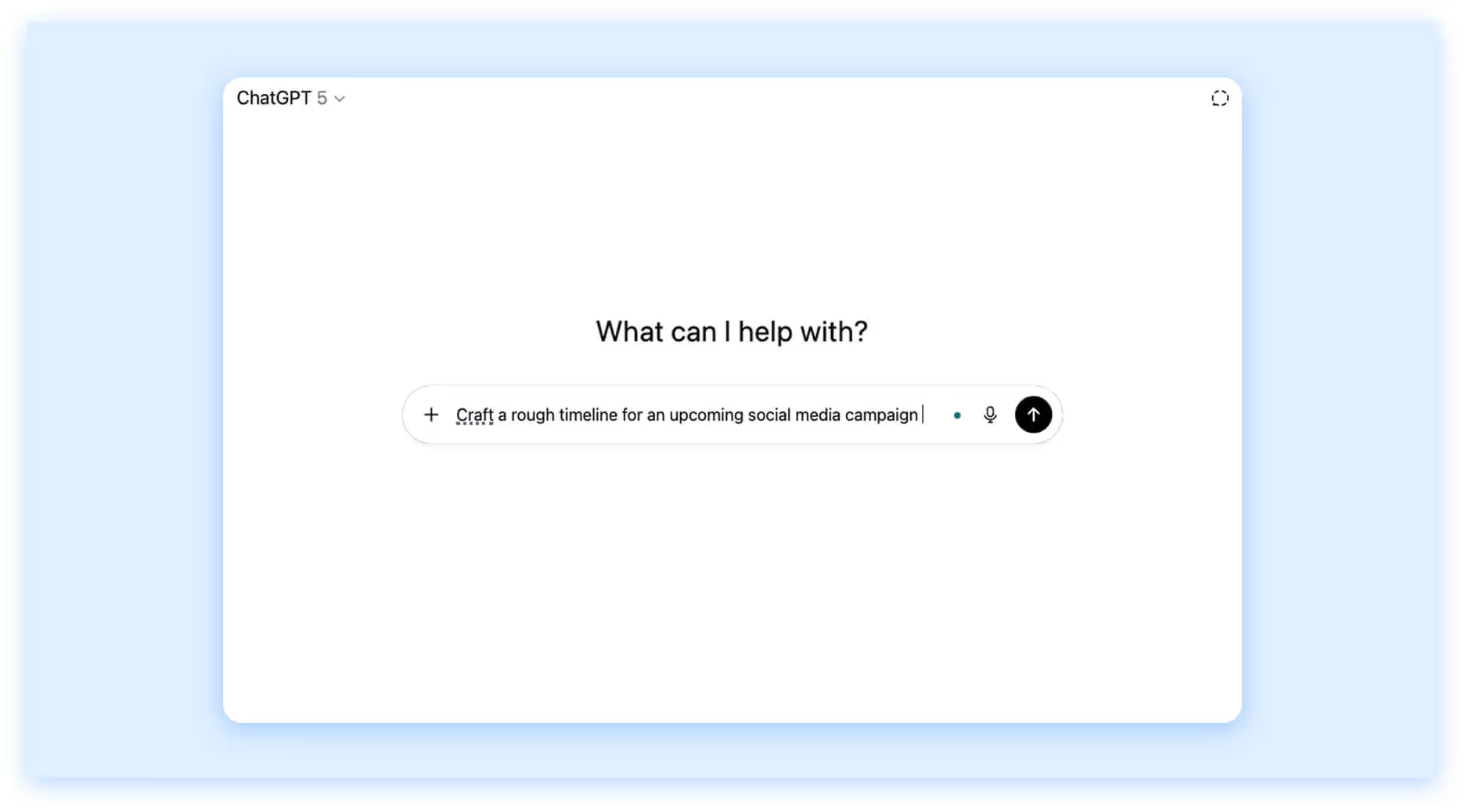
7. Jasper
Jasper specializes in creating long-form, on-brand content for marketing teams that need consistent tone and messaging across digital channels. Its AI learns a brand’s voice, tone, style, and visual guidelines to ensure every piece of content aligns with its identity and delivers a cohesive brand experience. Widely used for integrated campaigns, social media, copywriting, blogs, SEO, email marketing, and broader content strategies, Jasper also features an image model that detects content violations and recommends ways to fix them.
Pros:
- Strong for long-form, on-brand content, with support for tone/style control and global language support.
- Useful templates and SEO integrations make it relevant for content teams focused on scale.
Cons:
- Some users feel that output quality or originality may lag behind cutting-edge tools in certain use-cases.
- Requires careful input and editing to guarantee brand voice and accuracy.

8. Midjourney
Midjourney is an AI image-generation tool that transforms text prompts into high-quality, artistic visuals. It is widely used by marketers to create visuals for advertising, social marketing, and branding that match a brand’s creative direction. In fact, users no longer need Discord to use the tool, as it now offers a website-based platform for image generation where you can sign in with a Google account.
Pros:
- Offers a wide variety of styles and options, appealing for brand visuals, social marketing, creative work.
- Great option for generating realistic images.
Cons:
- The pricing structure or subscription tiers may be less transparent or cost-intensive for some.
- There may be a learning curve in crafting effective prompts for best results.

9. Lumen5
Lumen5 uses AI to turn written content, such as blogs, articles, scripts, or ideas, into engaging videos. Marketers can simply input an article, and the platform automatically selects visuals, music, and animations to match its tone. This allows teams to focus on storytelling and strategy while Lumen5 handles the heavy lifting, making it ideal for repurposing content for social media.
Pros:
- Users appreciate the simplicity of turning written content into engaging videos quickly.
- Templates, integrations and built-in media libraries make it accessible for non-video specialists.
Cons:
- Download and export formats or customization flexibility may be constrained in lower tiers.
- Some reviewers cite limitations in advanced video editing capabilities compared to full-featured tools.

10. DALL-E
Like ChatGPT, DALL·E is developed by OpenAI. It generates original, photorealistic images and graphics from natural language prompts, making it especially useful for marketers who need unique visuals for ads, blogs, social media posts, or product mockups without relying on stock imagery.
Pros:
- Intuitive interface makes it versatile for marketing visuals.
- High-quality image generation from natural-language prompts. Users appreciate its ease of use and creativity.
Cons:
- Some users find that image detail or realism falls short for very high-fidelity commercial work.
- Credits/usage cost can be high or limiting.

11. Writesonic
Writesonic offers a comprehensive suite of AI writing tools, but unlike ChatGPT, which is typically used for general writing tasks, it is purpose-built for marketing and SEO. It enables marketers to create SEO and AI search-optimized content, track performance, apply fixes, and boost search rankings across 30 languages. With its unique text-generation capabilities and deep integration with search data, Writesonic is ideal for producing content that not only reads well but also ranks well.
Pros:
- Tailored for marketing/SEO writing; supports multiple languages and integrates with search data.
- Good choice when the goal is both readability and search-ranking potential.
Cons:
- Pricing may be prohibitive for smaller organizations.
- Users report a high need for human oversight and editing.

12. Rytr
Rytr focuses on short-form AI copywriting, making it perfect for crafting catchy social captions, SEO headlines, and email subject lines. It is lightweight and easy to use, with a Chrome extension that works seamlessly across apps and websites. Affordable and beginner-friendly, Rytr offers a free plan with up to 10,000 characters per month and supports 30 languages. Its proprietary AI can also be trained to match each user’s unique voice, creating content that truly sounds authentic.
Pros:
- Excellent for short-form copy: captions, headlines, subject lines. Lightweight and beginner-friendly.
- Free plan availability for small usage or testing.
Cons:
- As a lighter tool, it may lack depth or advanced features found in larger platforms.
- Some users note lack of feature ability in higher-priced Enterprise packages.
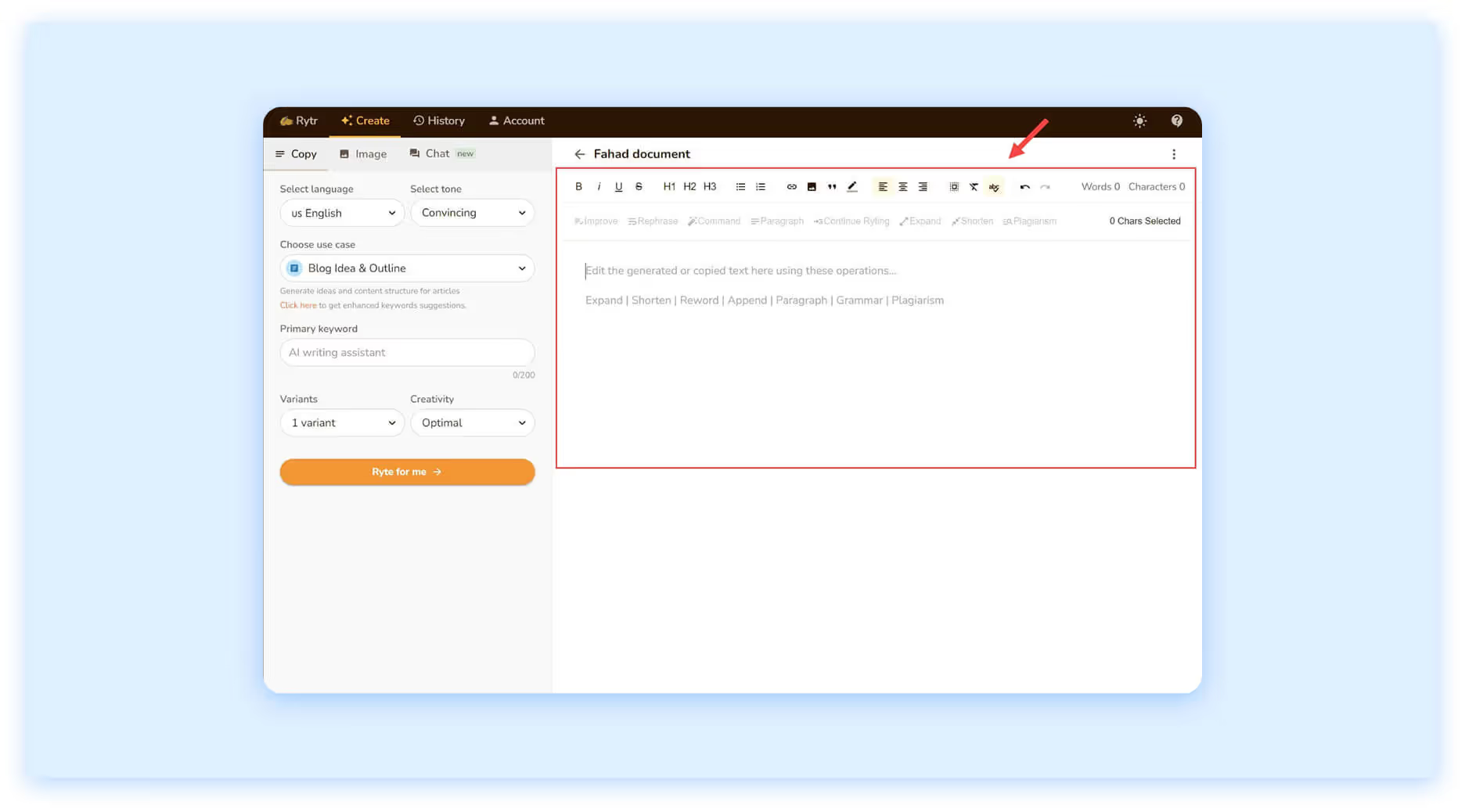
13. Copy.ai
Copy.ai helps businesses streamline their go-to-market (GTM) strategy by automating and optimizing account-based marketing, content creation, localization, and translation. Its AI tools enable marketing and sales teams to operate more efficiently and maintain consistency across global markets.
Pros:
- Useful for marketing/sales teams focusing on localization, translation, and GTM content creation.
- Supports multiple use cases and markets, which helps consistency for global brands.
Cons:
- May require more customization or manual review to match brand voice across languages.
- Some features may overlap with other writing tools, so differentiation is important.
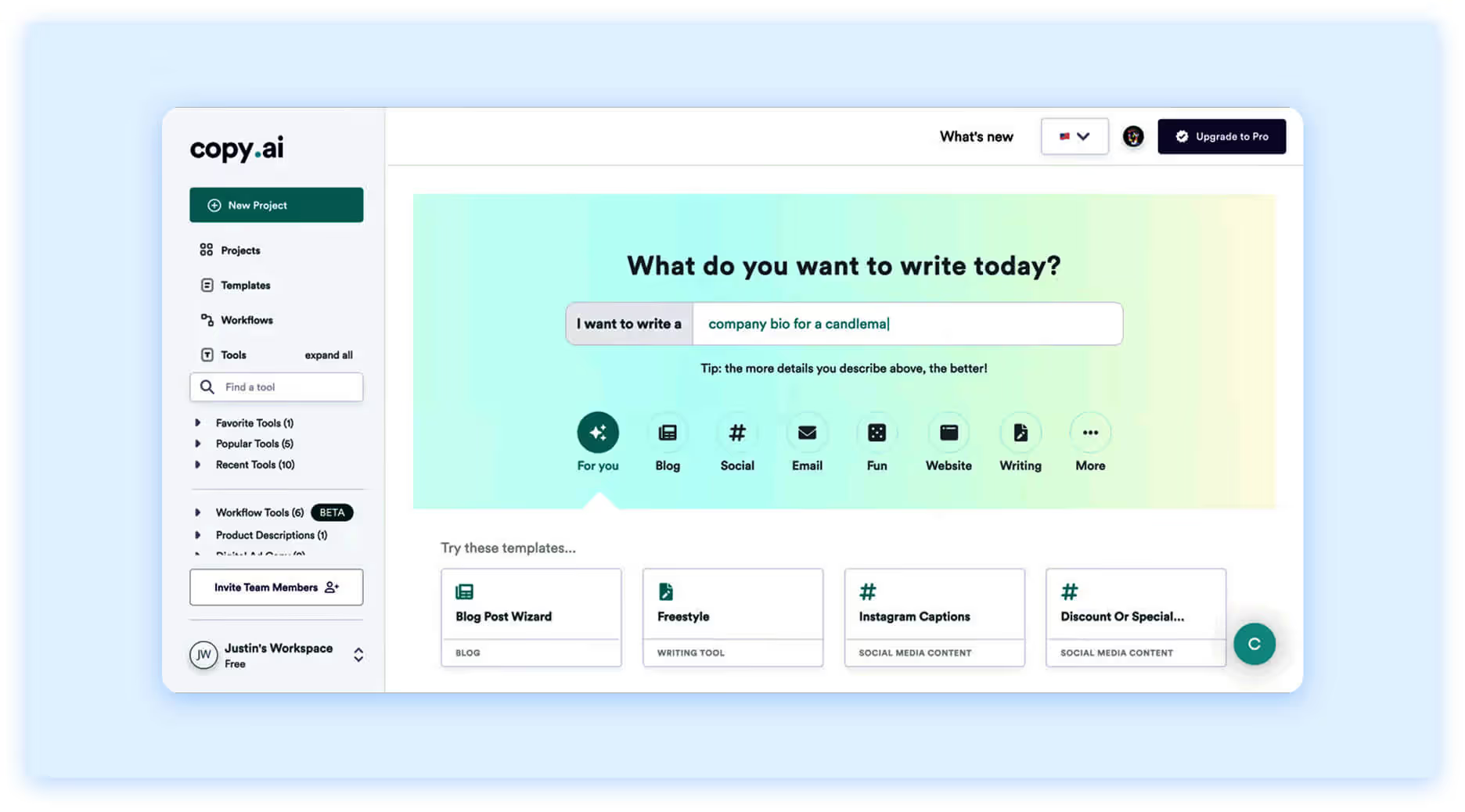
14. Beautiful.ai
Beautiful.ai can help automate presentation designs. Using AI, it instantly formats slides and aligns visuals while keeping layouts consistent. It's perfect for collaborative marketing proposals and performance reports that need to look polished fast. The tool also integrates with third-party tools like Dropbox, Slack, and Monday.com, making it easy to access and share presentations across teams.
Pros:
- Great for teams needing fast, polished presentation design; automates slide layout, aligns visuals.
- Good integrations (Dropbox, Slack, Monday.com) help collaborative workflow.
Cons:
- Less suited for deeply custom or brand-specific visual design requiring heavy edits.
- Some users may find the template style somewhat fixed compared to manual design tools.

15. AKOOL
AKOOL is an AI-driven platform for creating and editing video content at scale, supporting over 155 languages. It enables users to generate talking avatar images and videos from images, text, and audio; transform images into 4K videos; and create interactive or holographic avatars that can see, understand, and respond to viewers in real time. The platform also supports advanced edits such as face swaps, video translation, and special effects, making it ideal for interactive marketing campaigns and localized customer communication.
Pros:
- Supports advanced video content at scale like avatar generation, 4K video, face swaps, translation, and special effects.
- Multilingual support (155+ languages) makes it strong for global campaigns.
Cons:
- High complexity and advanced features may require significant setup and learning.
- Cost and resource demands may be high for smaller teams.
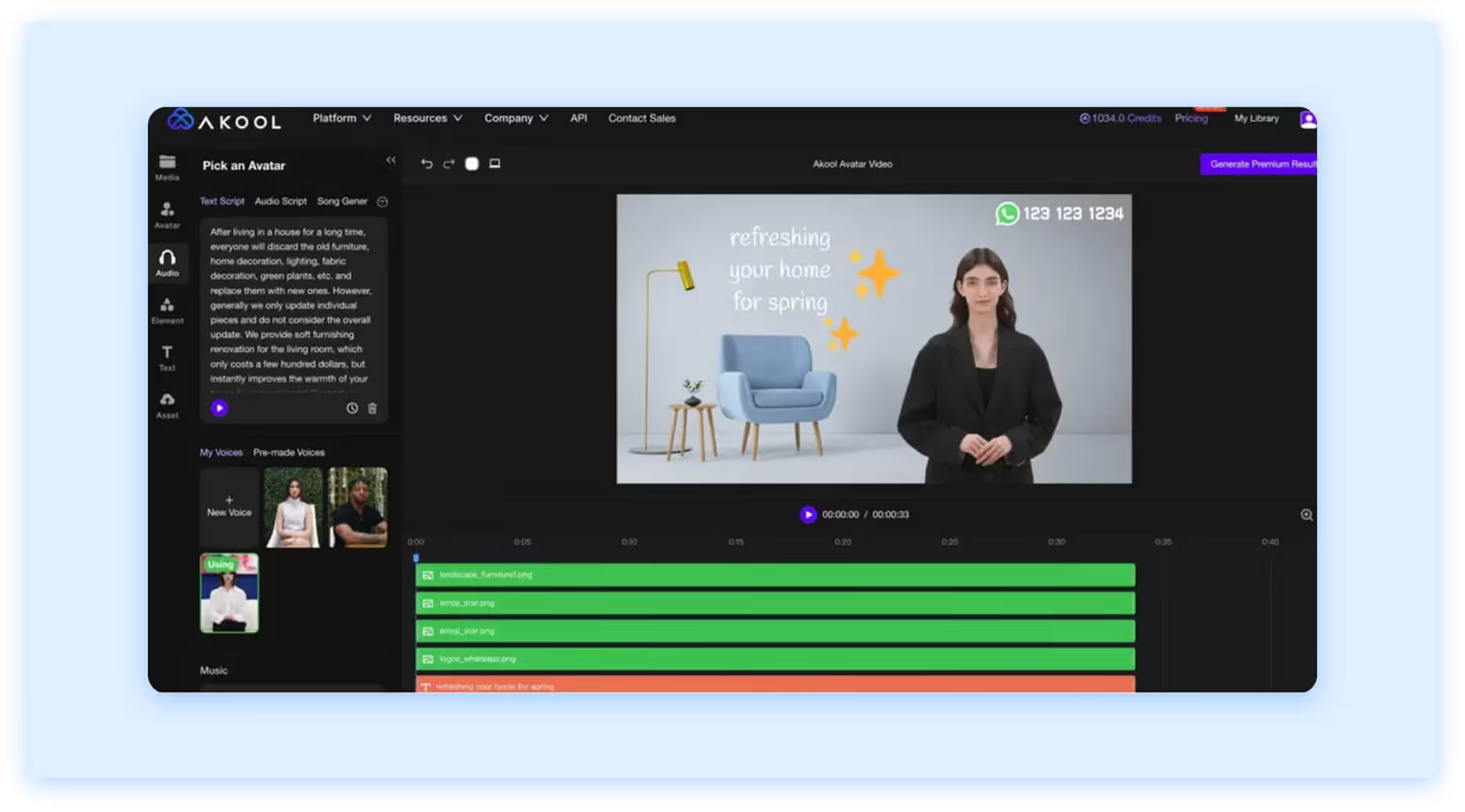
AI Tools For Consumer Insights
AI doesn’t just create content, it also helps marketers understand audiences on a deeper level. The tools below process datasets and help uncover trends, behaviors, and conversion drivers.
16. Blueshift
Blueshift is an AI-powered customer data platform (CDP) that unifies cross-channel marketing and customer data from multiple sources while predicting the next best action for each user. Its predictive intelligence enables marketers to create, automate, and scale personalized experiences across every channel, including email, web, SMS, push notifications, paid media, and more.
Pros:
- Strong for unifying multi-channel customer data and applying predictive intelligence for next-best-action.
- Good fit for marketers who want to scale personalized experiences across email, web, SMS, and paid media.
Cons:
- Implementation can be complex because it touches many data sources and channels.
- Requires clean data and a marketing operations-ready team to extract full value.
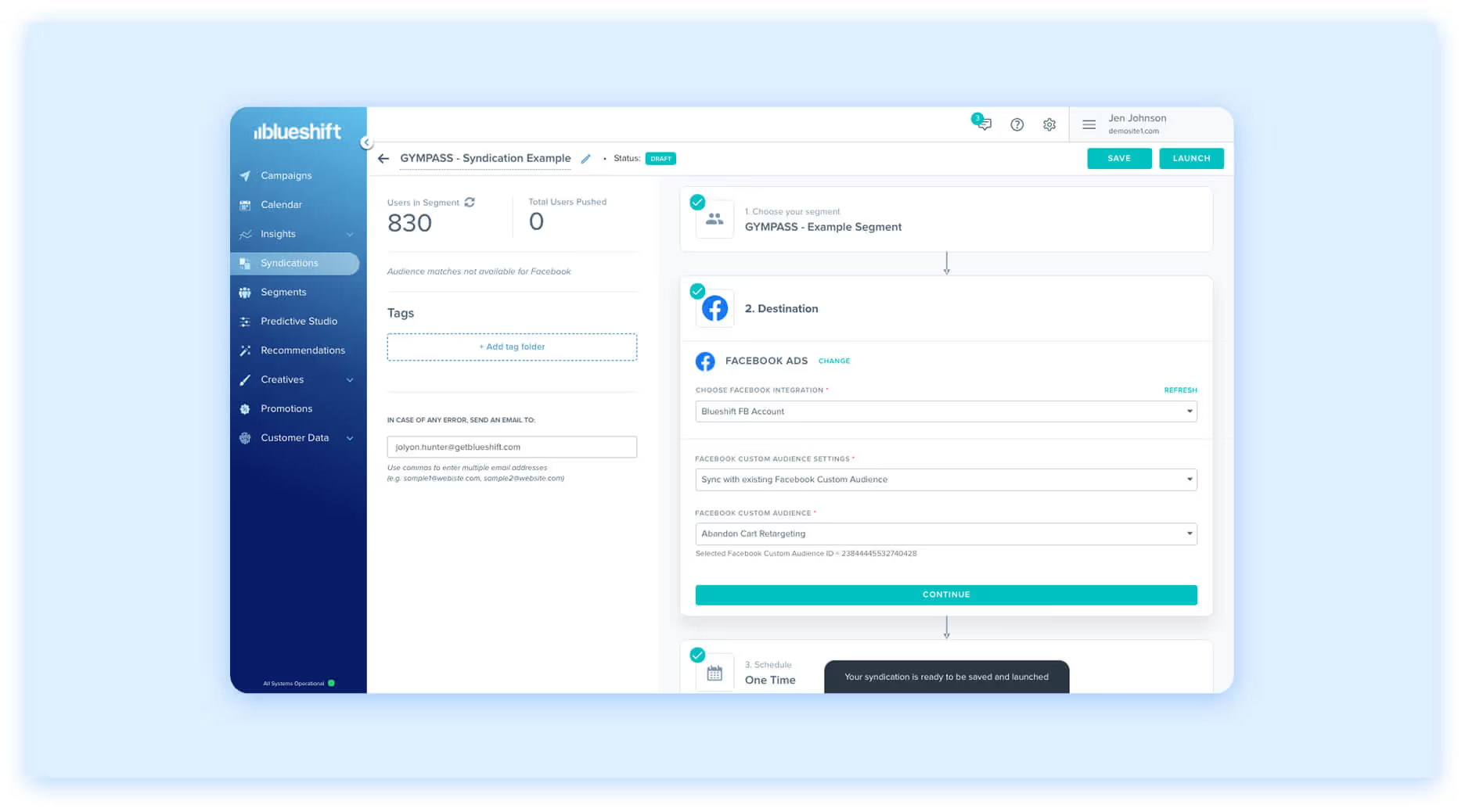
17. The Trade Desk
The Trade Desk is an independent, cloud-based demand-side platform (DSP) that enables advertising buyers to create, manage, and optimize data-driven digital ad campaigns through a self-service model. Its on-platform AI enhances programmatic advertising by helping marketers identify high-value audiences, forecast reach, and efficiently manage omnichannel campaigns. The platform supports a wide range of channels, including audio (streaming music, news, live sports, and podcasts), connected TV, digital billboards and screens, display and mobile ads, native placements within editorial content or recommendation widgets, and video ads that run before, during, or after content.
Pros:
- Established demand-side platform (DSP) with strong tools for audience identification, forecasting, and omnichannel campaign management.
- Enables marketers to manage display, video, audio, connected TV, mobile, native in a self-service model.
Cons:
- Complexity and sophistication mean a steep learning curve for non-programmatic marketers.
- Pricing and minimum spend levels may exclude smaller teams or niche budgets.
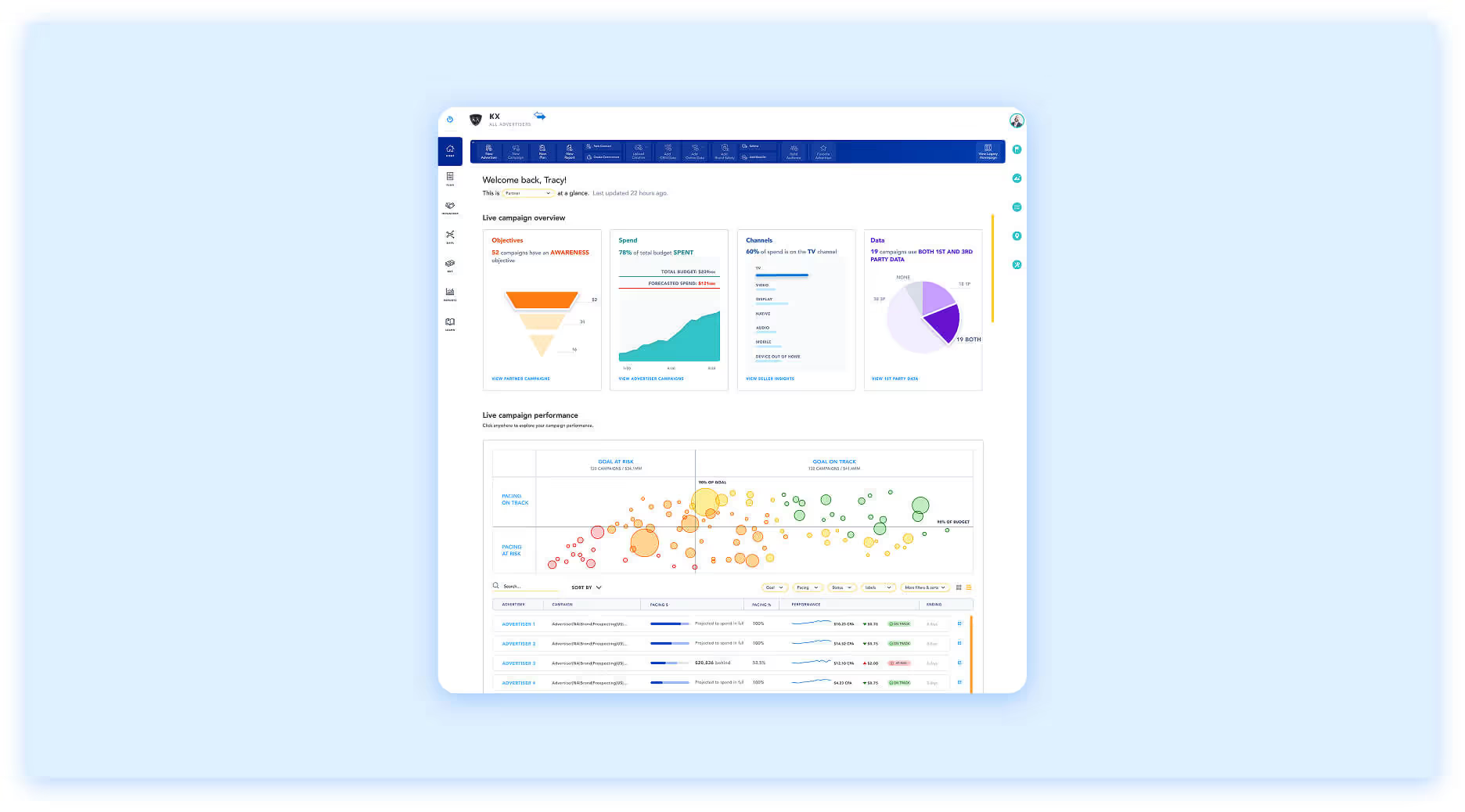
18. GumGum
GumGum uses contextual AI to analyze the content surrounding ads, without relying on personal data, across digital environments at scale. Its AI-powered data engine enables smarter ad placements through its Context, Attention, and Creative solutions, evaluating the relevance of each page to improve engagement, effectiveness, and brand safety.
Pros:
- Uses contextual AI to place ads based on page content rather than personal data, which can be advantageous for privacy-aware advertising.
- Strong focus on relevance, brand safety, and creative optimization.
Cons:
- Because it uses context rather than personal data, it may offer less granular targeting than some user-data-driven platforms.
- Smaller user base of public review feedback, making benchmarking harder.

19. TextCortex
Unlike most text-based AI tools, TextCortex goes beyond simple content generation by integrating AI directly with a company’s own marketing data and internal knowledge base. This allows teams to automate workflows, uncover actionable insights, conduct market research, and create highly personalized campaign content with ease. Supporting more than 25 languages and powered by multiple large language models (LLMs), TextCortex ensures every output aligns with the brand’s tone and messaging, making it an ideal solution for global businesses that need consistent, on-brand communication across markets.
Pros:
- Integrates with company data/knowledge base so output is more aligned to brand tone and internal workflows.
- Supports multiple languages (25+), good for global businesses needing a consistent voice.
Cons:
- Because it’s newer or less publicized, fewer user reviews mean less benchmarking data.
- Implementation may require setup of an internal knowledge base and training for best results.
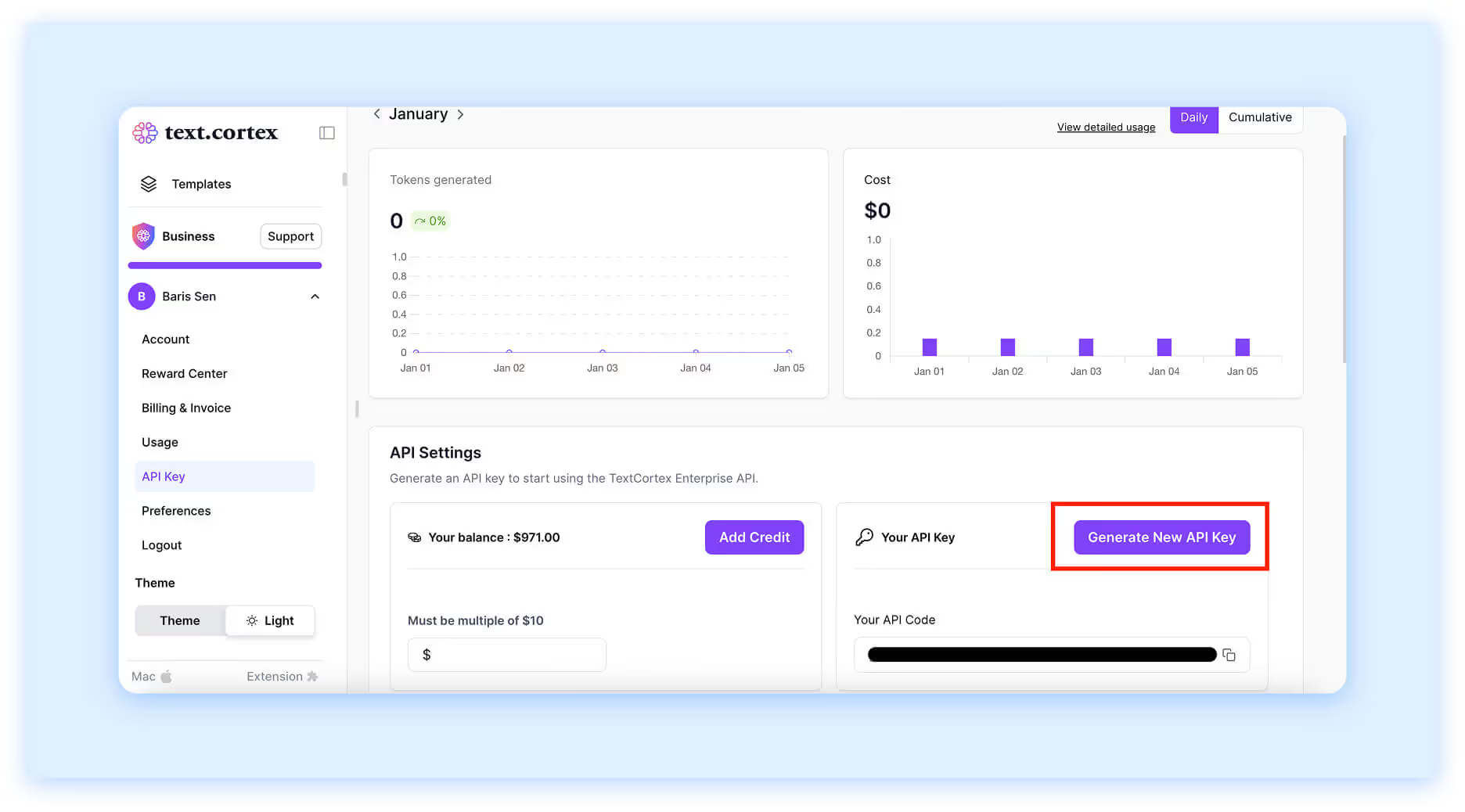
AI Tools For Email Marketing
Email marketing is evolving beyond templates and sending schedules. Emailing AI tools now summarize performance, personalize content, and predict which messages convert best.
20. HubSpot
HubSpot integrates AI across its CRM and marketing suite to help teams save time and work smarter. Its AI agent can summarize brand performance from marketing emails, reports, and feedback surveys, while its AI email generator uses natural language processing and machine learning to simplify the process of drafting marketing and sales emails. By helping teams develop on-brand messaging tailored to each audience segment, it boosts open rates, engagement, and campaign efficiency. This makes it an ideal solution for marketing and sales teams looking to personalize email communication at scale and streamline everyday workflows.
Pros:
- Widely adopted CRM/marketing suite; AI features add value by summarizing performance, drafting emails, segment-specific messaging.
- Good fit for marketing and sales teams wanting personalized communication at scale.
Cons:
- To fully leverage AI features, organizations often need mature operations and proper data hygiene.
- As part of a larger hub, may include features you don’t use (and pay for) if only using certain modules.

AI Tools For Sales
Sales and marketing alignment is crucial, and these AI tools bridge the gap by analyzing calls, automating workflows, and predicting deal success.
21. Gong
Gong uses AI to analyze sales calls and meetings, uncovering insights about customer sentiment, talk ratios, deal risks, and emerging trends. Its work doesn’t stop there, though: after each call, its AI agent generates account briefs, drafts follow-up emails, and automatically updates the CRM to eliminate manual data entry. By streamlining post-call tasks and surfacing actionable insights, Gong helps teams improve pipeline conversion, accelerate sales cycles, and strengthen sales enablement and coaching.
Pros:
- Reduces time surfacing insights and action items from sales calls and meetings.
- Helps with pipeline conversion, accelerates sales cycles and supports coaching and enablement.
Cons:
- Analysis output still often requires human judgement and action.
- For smaller sales teams, the value may not outweigh the investment unless scale and process maturity exist.
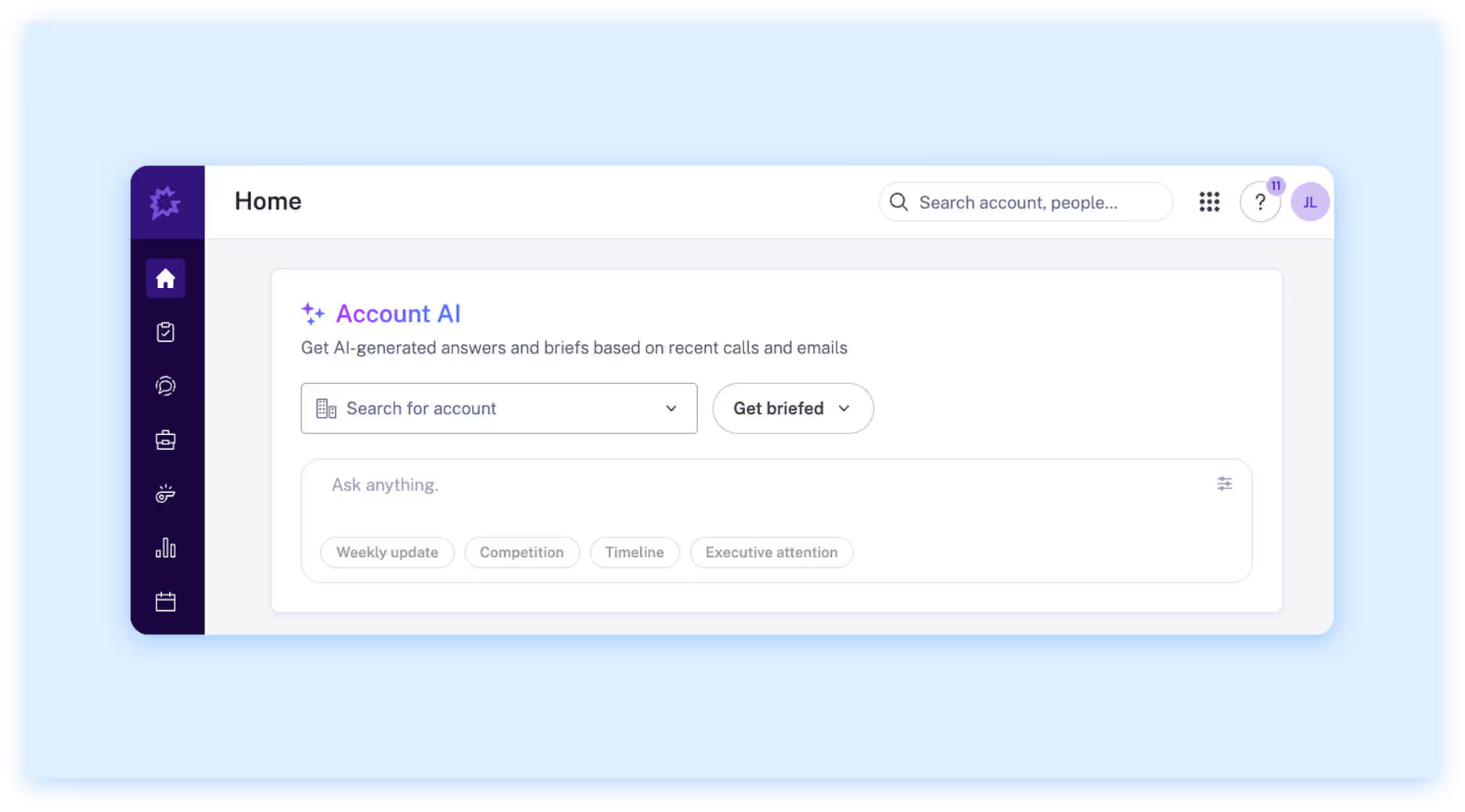
22. Kore.AI
Kore.AI provides intelligent virtual assistants that automate and optimize conversations across internal operations, customer service, and sales. Internally, it can search enterprise knowledge, summarize meetings, and automate workflows to help teams handle repetitive tasks efficiently.
For customer-facing interactions, the AI delivers human-like, multi-turn conversations while offering real-time suggestions to human agents, enabling faster resolutions and more personalized support. On the sales side, it supports proactive, data-driven outreach, creating personalized and scalable campaigns that strengthen customer loyalty and drive revenue growth. This makes Kore.AI an ideal solution for enterprises looking to enhance productivity, customer experience, and engagement through conversational AI.
Pros:
- Strong conversational AI platform for internal operations and customer service, sales, including summary of meetings, virtual assistants, and proactive outreach.
- Multi-turn conversations, real-time suggestions, and broad channel support make it capable for enterprise use.
Cons:
- Fewer publicly-disclosed user-reviews compared to more established tools.
- Complexity and technical requirements may make adoption slower for smaller teams.

23. IBM Watsonx Assistant
IBM Watsonx Assistant leverages large language models (LLMs) to create sophisticated AI chatbots for sales and customer engagement. Its enterprise-grade capabilities enable businesses to provide seamless self-service experiences and highly personalized support, making it an essential tool for scaling operations and enhancing customer satisfaction.
Pros:
- Enterprise-grade chatbot/assistant solution built on large-language models (LLMs) that supports highly personalized and scalable self-service experiences.
- Good for scaling customer engagement, reducing manual support costs, and improving satisfaction.
Cons:
- Implementation complexity, especially with data-integration and enterprise workflows.
- Licensing and cost structure may be substantial.

24. Salesforce Customer 360
Salesforce Customer 360 provides a holistic view of all customer data and interactions by integrating information from sales, service, marketing, and e-commerce into a single, unified profile. The platform predicts customer needs, recommends next steps, and automates key parts of the sales process. By giving businesses a deeper understanding of their customers, it enables personalized interactions, improves service, identifies cross-selling and upselling opportunities, and ultimately enhances customer satisfaction and loyalty.
Pros:
- Unified view of customer data spanning sales, service, e-commerce marketing with predictive analytics and automation support to upsell/cross-sell and personalize interaction.
- Good fit for organizations looking to unify fragmented customer data and operate at scale.
Cons:
- Complexity and cost can be high; the platform requires organizational readiness and proper data architecture.
- Implementation often involves time, resources, change management, making it challenging for smaller teams to adapt.
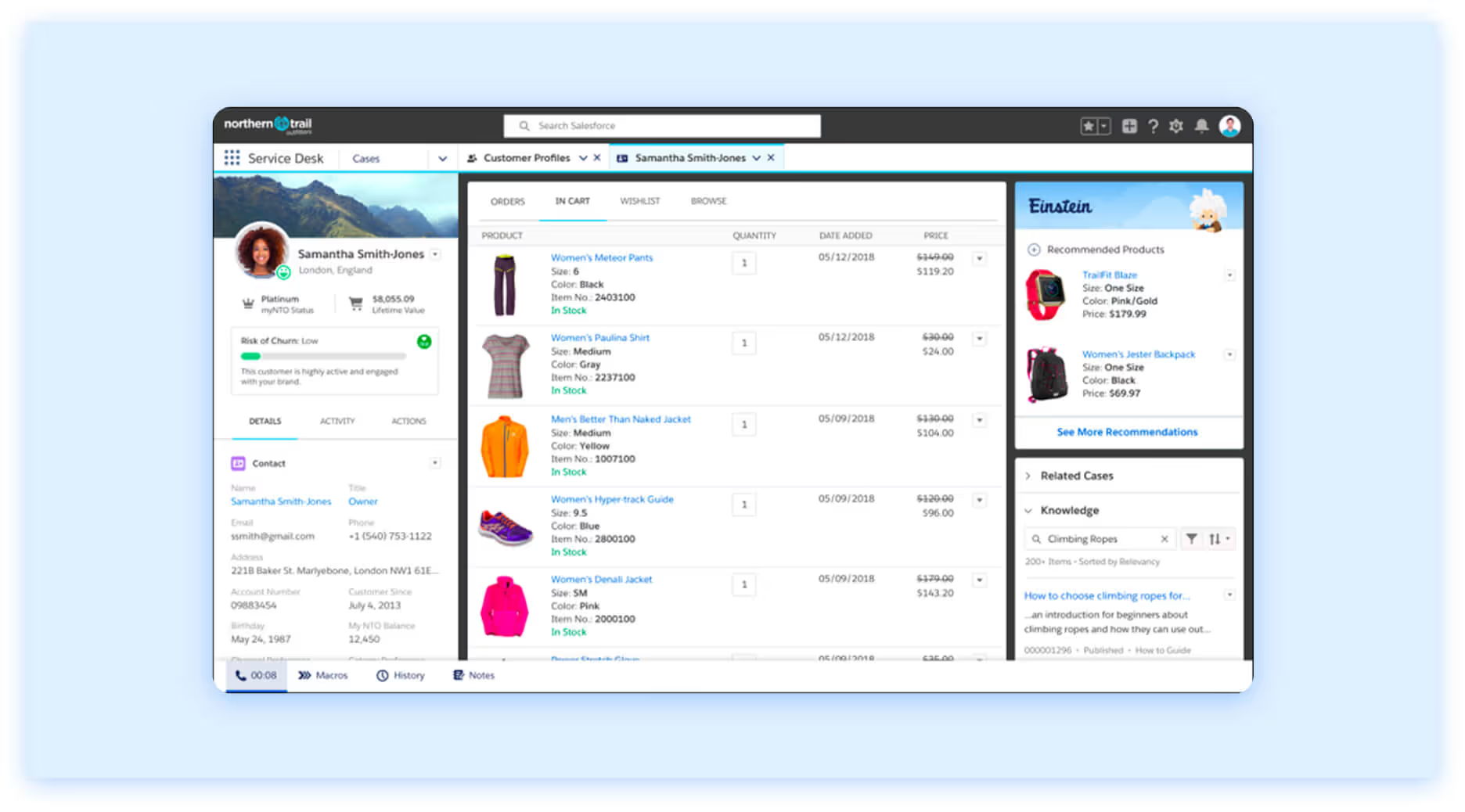
AI Tools For Data Analysis
Marketers deal with overwhelming amounts of data, and AI tools can make sense of it all. The platforms below help turn raw information into actionable insights.
25. Notion AI
Notion AI enhances productivity by summarizing notes, extracting key insights from documents and connected apps, and automating everyday workflows. Backed by a vibrant community that shares ready-to-use templates, it helps teams organize ideas, manage campaign data, and plan projects collaboratively. It’s an excellent choice for marketers who value efficiency and structure in their daily work. Notion AI offers a free individual plan, with team plans starting at $10 per member per month.
Pros:
- Helps with productivity tasks like note-taking, extracting insights from documents/apps, and automating workflows. Good for marketing teams needing structure, collaboration, and organisation.
- Free individual plan gives entry point; good for small teams or testing.
Cons:
- While strong for managing productivity and workflows, not always suitable for complex, deeper data analysis.
- Some advanced features require a paid tier; for teams requiring heavy scale, may require integration with other tools.

26. Adobe Experience Platform (AEP)
Adobe Experience Platform (AEP) is a real-time Customer Data Platform (CDP) that centralizes the tools and components needed for audience management, customer insights, engagement, and experimentation across Adobe’s applications. Its AI Assistant and Agent Orchestrator enable teams to take data-driven actions. The AI Assistant delivers marketing and operational insights while improving product knowledge, while the Agent Orchestrator streamlines and enhances cross-channel customer experience and interactions. Unlike the widely used Adobe Experience Cloud, which is a suite of marketing tools, AEP is the enterprise-grade, centralized data foundation that powers the applications within Experience Cloud.
Pros:
- Enterprise-grade real-time customer-data-platform with AI Assistant and Agent Orchestrator for cross-channel engagement and experimentation.
- Strong for audience management, personalization, data-driven marketing operations at scale.
Cons:
- Very steep implementation, requires significant investment in data infrastructure and specialist skills.
- Might be over-specified for smaller marketing teams or businesses without large data operations.
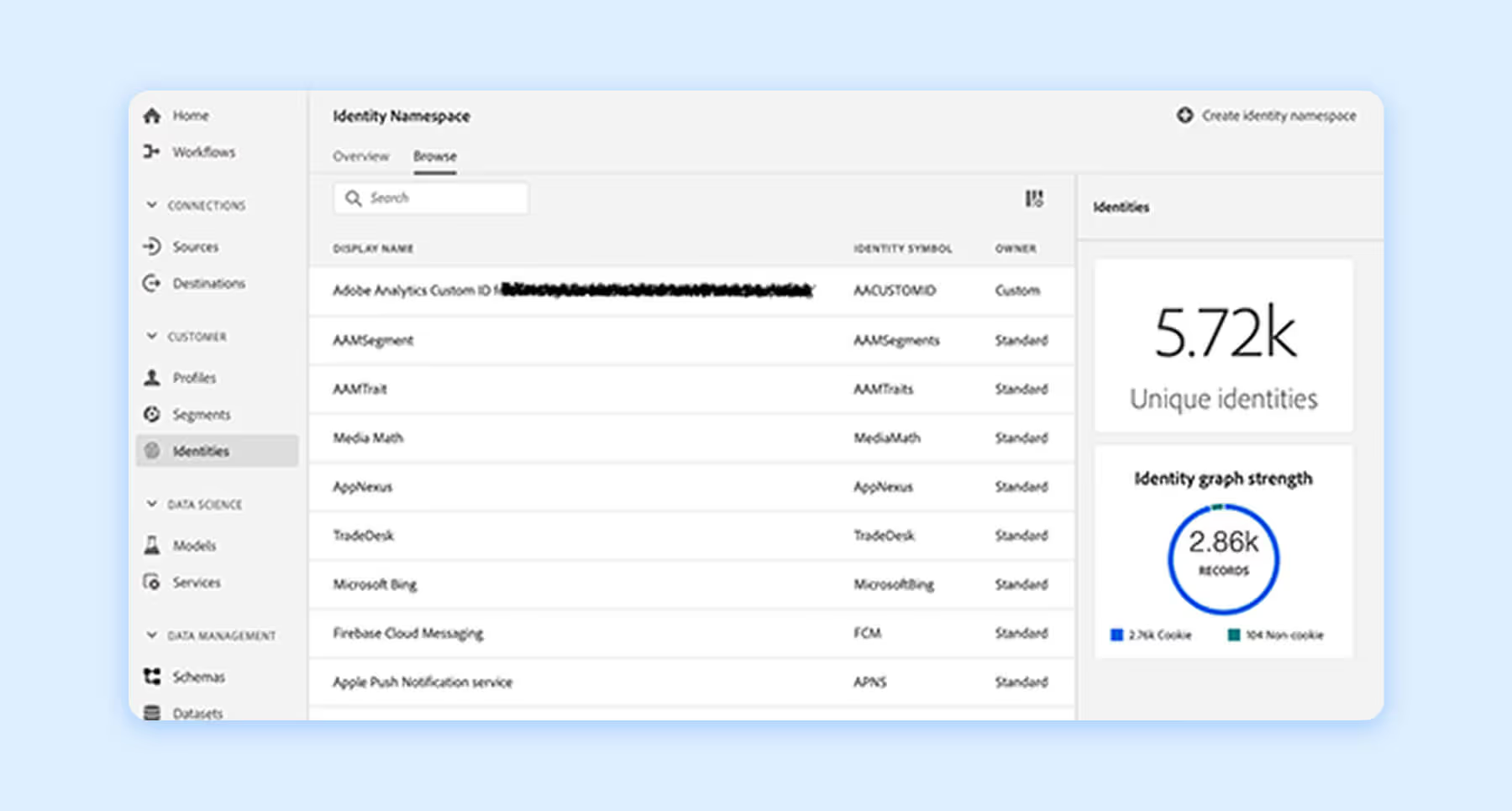
27. Google Vertex AI
Vertex AI is Google Cloud’s unified platform for building and deploying generative AI. It offers access to over 200 generative AI models, along with tools for training, tuning, and deploying machine learning models to create a wide range of AI agents. As Google shared, marketers can use Vertex AI to draft campaign briefs, analyze creative assets, and turn static images into motion videos. It’s an ideal solution for marketing teams, data scientists, and developers looking to streamline content creation, gain actionable insights, and scale personalized experiences.
Pros:
- Google Cloud platform for building and deploying generative AI, with access to 200+ models, making it ideal for teams with data science and dev resources.
- Ideal for users comfortable with the Google environment or who already leverage Google tools.
Cons:
- Requires technical expertise.
- For typical marketing-team use, might offer more than what’s needed, and simpler tools may suffice.

28. Gemini Enterprise
Google Gemini is an enterprise-level AI suite built for advanced data reasoning, real-time research, multimodal processing, and seamless integration with Google products. Unlike ChatGPT, which excels at brainstorming and conversational tasks, Gemini enables marketers to predict trends, analyze performance data, and fuel creative ideation. It’s an ideal solution for marketing teams, analysts, and enterprise users who need powerful AI tools to inform strategy, generate insights, and make data-driven decisions.
Pros:
- Gemini Enterprise supports text, image, document, and code input, offering a great range of options for marketers seeking a multi-functional tool.
- The platform includes features like data isolation, audit logs, and enterprise system connectors, which help organizations protect sensitive marketing data.
Cons:
- Very high level capability: may require significant team maturity, data maturity, and budget.
- It may be less accessible to smaller teams or those without a dedicated AI/analytics infrastructure.
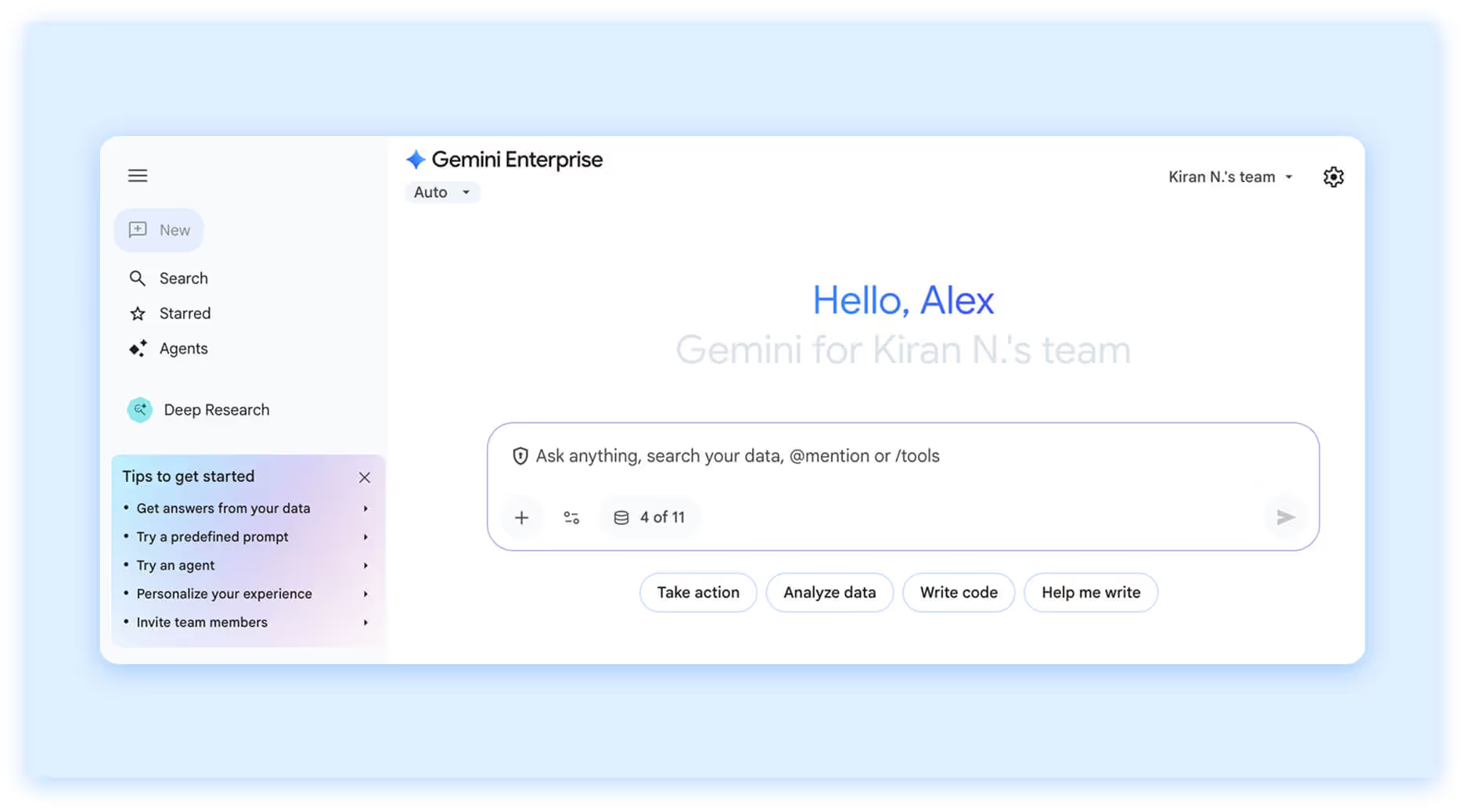
AI Marketing Tools FAQs
Are AI marketing tools suitable for small businesses?
Absolutely! Many AI tools offer flexible pricing, and even free plans and tokens, making them accessible to small businesses without large budgets. Tools like ChatGPT or Copy.AI can help generate ideas and streamline tasks for free.
What’s the difference between AI-powered analytics and traditional marketing analytics?
Traditional analytics focuses on historical data, providing a rearview mirror for marketing reporting. In contrast, AI-powered analytics provide a self-driving, future-facing navigation system for the entire marketing ecosystem, using machine learning and predictive modeling to study past performance, forecast outcomes, suggest optimizations, and identify opportunities automatically.
What data do AI marketing tools need to work effectively?
AI marketing tools require different data to work effectively, all depending on what you’re using them for. For creative assets, you might want to share demographic data to help craft visuals that resonate with your audience, while data analysis tools often require integrated data, like behavioral data (website clicks, engagement, journey history), transactional data (purchase history, ACV, price sensitivity), or performance data (campaign ROI, A/B test results).
How do AI tools help with A/B testing and optimization?
AI tools enhance A/B testing and optimization by transforming the workflow from a slow, manual process to a fast, scalable, and continuously optimizing system.




